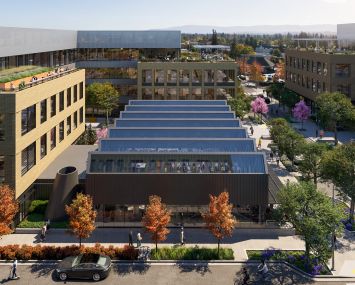The Cloud and Co-Location Centers Draw More Firms’ Data Amid Recession Fears
The pandemic had already accelerated the trend away from on-site data servers
By Celia Young February 21, 2023 9:00 am
reprints
Nobody wants an economic recession. But cloud and data center providers might not mind one.
For more than two decades, companies have been ditching their in-office servers for servers managed by third-party operators and for space in the cloud — where Google (GOOGL), Microsoft, Amazon (AMZN) Web Services and others offer up computing power for purchase.
A recession would likely encourage even more firms to ditch their on-premises equipment.
“I think [a recession] throws gasoline on the fire,” Robert Meyers, a senior vice president of data center solutions for CBRE (CBRE), said. “A recession is exactly the environment that helps data centers grow because people don’t want to invest that money in a recession, [with] supply chain issues about getting those parts, in enhancing your office environment to house your equipment.”
So a potential recession certainly didn’t start the fire — it was always burning as the world’s been churning out more and more information. That has forced firms to look to third-party providers to protect their data, Meyers said. But between the pandemic and an economic downturn, the flames might get a lot hotter (and not just because of those poor, overheated computers).
Companies have turned to co-location data centers, buildings chock-full of servers hosting a handful of firms’ information, to better protect their data from power outages and storms than a traditional office. Hurricane Sandy in 2012 underscored this level of protection as the storm temporarily shut down Gawker, BuzzFeed and the Huffington Post after the basement Manhattan server space they shared flooded.
More recently, firms have turned to the cloud, which lets companies purchase only the computing power they need without owning the server equipment, though most use a mix of the cloud and co-location data centers, Meyers said. Law firms in particular have transitioned to the cloud and co-location space, said Jonathan Meisel, a CBRE data center broker based out of New Jersey.
When the pandemic physically locked people out of their offices, it was a wake-up call for companies who couldn’t access their on-site servers, said Meisel. Co-location and the cloud became more appealing as hybrid work took over, because without office-based servers it’s a lot easier to move or downsize, he added.
“You see companies paring down their reliance on on-site servers because of flexibility for their office space,” Meisel said. “It’s not the tail wagging the dog anymore.”
It’s not only flexibility — data centers tend to be cheaper than office-based operations, said Matthew Gleason, vice president and general manager for the data center provider CoreSite. And cheap is what companies look for when tightening their belts.
“I think it’s going to make more folks sit down and do the math,” Gleason said. “If you’re strictly looking at it from an economic perspective, I think more folks will be doing the math and realizing the cost benefits of co-locating their data servers. Once they do that, then I think they start realizing all the technical advantages for doing so.”
During the 2008 and 2009 recession, firms looked to cut costs by moving their operations to co-location data centers, said Kyle Verzello, chief operating officer for the data center provider ColoHouse. He expected companies to consider outsourcing their IT operations to cut costs while holding on to the same level of service.
The cost of server space in a data center varies, depending on the amount of space a company needs and who manages it, said Matthew Landek, an account executive with JLL (JLL) who advises data center users. Co-location centers and the cloud tend to be more cost efficient because they include protections, though completely working off of the cloud can be pricey, Meyers added.
The average price of an on-premises server is roughly $1,476 a month while the average price for a cloud server with the same configuration is about $313.90, according to Sherweb, a cloud provider. Meanwhile, renting a single tray within a data center can cost around $250 a month, while an entire rack can cost as much as $2,000 a month, according to Volico, a data center and cloud service provider.
Some bigger companies have already abandoned control of their IT operations to save money. Uber announced Feb. 13 it would ditch its own data centers in favor of cloud platforms operated by Google and Oracle, Bisnow reported. Uber, which houses 95 percent of its IT infrastructure in data centers it owns or leases, will close its self-operated facilities thanks to the deal.
More firms are likely to be drawn to the cloud amid a recession, said Andy Power, president and CEO of Digital Realty, which operates more than 300 data centers globally.
“In the current environment, cloud adoption is the next generation of corporate outsourcing, writ large,” Power said. “The cloud is gaining traction because it enables corporate enterprise end-users to achieve efficiencies and contain costs. During a downturn, this becomes even more appealing.”
The growth of the cloud doesn’t necessarily mean the total disappearance of data centers, said JP Laqueur, senior vice president of marketing for the data center operator DataBank. Some firms in heavily regulated industries like credit card processing need private servers to meet compliance laws, he said. And data center companies have enjoyed strong revenue growth as usage has increased.
Iron Mountain, which operates 11 data centers in North America, saw revenue hit $1.29 billion in the third quarter of 2022, an increase of 13.9 percent compared to the same period in 2021, according to its third-quarter earnings report. Digital infrastructure firm Equinix, the operator of more than 240 data centers across the globe, recorded revenue of $1.87 billion in the fourth quarter of 2023 — its 80th straight quarter of growth — according to the firm’s fourth-quarter earnings report. Digital Realty saw its revenue rise to $1.23 billion in the fourth quarter of 2022, though its funds from its operations were less than expected, The Washington Post reported.
While a recession might not stop this skyrocketing growth, the lack of land, power and time to build new data centers could, Laqueur said. A single rack in a data center might need 100 kilowatts of energy to power and cool it, and it’s been a challenge for utility companies to deliver that much power, Laqueur added.
For example, in Virginia, Dominion Energy sent shockwaves down the data center industry when it revealed it would not be able to deliver enough power to several planned developments in Loudoun County. That threw some projects, including some of Digital Realty’s, into doubt, Bisnow reported. With uncertain power resources, supply chain issues and rising interest rates, growth in new data center construction could slow in 2023.
“Power is going to be and already is a challenge,” Laqueur said. “This is very much on the radar screen for everybody in this industry.”
Celia Young can be reached at cyoung@commercialobserver.com.


